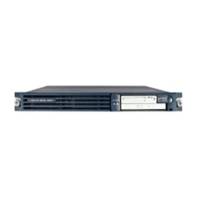3-16
Cisco Unified Communications Manager Managed Services Guide
OL-22523-01
Chapter 3 Managing and Monitoring the Health of Cisco Unified Communications Manager Systems
RTMT Monitoring of Cisco Unified CM System Health
Virtual Memory
Virtual memory consists of physical memory (RAM) and swap memory (Disk). The RTMT CPU and
Memory window has system level memory usage information as the following:
• Total—Total amount of physical memory
• Free—Amount of free memory
• Shared—Amount of shared memory used
• Buffers—Amount of memory used for buffering purpose
• Cached—Amount of cached memory
• Used—Calculated as Total – Free – Buffers – Cached + Shared
• Total Swap—Total amount of swap space
• Used Swap—Amount of swap space in use on the system.
• Free Swap—Amount of free swap space available on the system
Note Using SOAP APIs, you can query memory information for the following perfmon counters:
• Under Memory object—% Mem Used, % VM Used, Total Kbytes, Total Swap Kbytes, Total VM
Kbytes, Used Kbytes, Used Swap Kbytes, Used VM Kbytes
• Under Process object—VmSize, VmData, VmRSS, % Memory Usage
Using SNMP, you can query the following perfmon counters:
• Host Resource MIB—hrStorageSize, hrStorageUsed, hrStorageAllocationUnits, hrStorageDescr,
hrStorageType, hrMemorySize
Note You can download some historical information by using RTMT Trace Log Central. The Cisco AMC
Service PerfMonLog is enabled by default. The Cisco AMC Service PerfMonLog is deprecated in Cisco
Unified CM Release 6.0 because Cisco RIS Data Collector PerfMonLog was introduced. The Cisco RIS
Data Collector PerfMonLog disabled by default in Cisco Unified CM Release 5.x and enabled by default
in Cisco Unified CM Release 6.0.
Note Perfmon Virtual Memory refers to Total (Physical + Swap) memory whereas Host Resource MIB Virtual
Memory refers to Swap memory only.
The RTMT Process window displays process level memory usage information as follows:
• VmSize—Total virtual memory used by the process
• VmRSS—Resident Set currently in physical memory used by the process including Code, Data and
Stack
• VmData—Virtual memory usage of heap by the process
• Page Fault Count—Represents the number of major page faults that a process encountered that
required the data to be loaded into physical memory
Figure 3-5 shows RTMT Process window. You can sort VmSize by clicking on VmSize tab. Then you
can identify which process consumes more memory.

